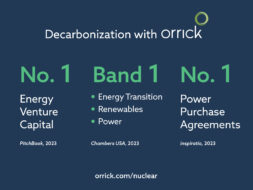Authored by Justin Lee Porter, Jonathan Camello, Jon O’Connell, and Sam Edwards
Just a few years ago, launching a nuclear energy start-up in the United States was an exercise plagued with uncertainty. Regulatory timelines were opaque, licensing costs were burdensome, and securing venture funding was challenging based primarily on the sheer lack of clarity. Recently, however, a profound shift has begun to take shape—one powered by a flurry of federal actions that could transform the nuclear energy landscape, sparking growth and innovation in the industry.
The regulatory shift began to take shape in May when President Trump signed a package of executive orders aimed at overhauling nuclear regulation. These directives compel the Nuclear Regulatory Commission (NRC) to enforce strict licensing deadlines, including 18-month timelines for new reactor approvals and just 12-month timelines for renewals. Meanwhile, the Department of Energy (DOE) is being pushed to move swiftly. Under new mandates, the DOE must kick off a pilot micro-reactor project by next summer. For start-ups developing micro-reactors and modular designs, this could prove to be a direct road to potential commercialization.
Legislation is marching in tandem with executive action. The ADVANCE Act, signed last year, is reshaping the regulatory landscape for advanced reactors. Not only does it cut pre-application NRC fees nearly in half, but it also lays out technology-specific licensing frameworks that treat small modular, micro, and even fusion reactors differently from legacy gigawatt-scale plants. Startups chasing fusion breakthroughs finally have rules built for their scale and physics, instead of navigating a more uniform, dated, one-size-fits-all system designed for last century’s reactors.
The regulatory shake-up sparked by the aforementioned executive orders have continued to gain momentum as of late. In June, the NRC made a groundbreaking decision to allow microreactors to be fueled at the factory, avoiding costly multi-step approvals. This change supports a future where small reactors can be built, fueled, and shipped like any high-tech asset, dramatically shortening the route to revenue for startups in this market who have long dealt with uncertain and extended paths to profitability.
We are seeing building private momentum in the wake of this regulatory reformation as well. Google’s recent deal to buy future fusion energy from Commonwealth Fusion Systems (CFS) underscores how large tech buyers are now in the market for dependable nuclear power. This is a welcome development for entrepreneurs in contrast to the prior reluctance of tech giants (like Google) to invest in nuclear energy due to previous long lead times and red tape.
All of this provides long-missing efficiency, predictability, and credibility into processes that previously had the potential to meander for years on end with uncertainty. For early-stage companies trying to raise capital, time is of the essence and with this added certainty and efficiency from a regulatory perspective, investors can better model returns and invest more confidently in start-ups in the nuclear energy space.
Although these shifts in the policy landscape are encouraging, they by no means eliminate regulatory burdens on the emerging nuclear energy market entirely. Start-ups still must navigate complex design certifications, rigorous safety cases, and evolving non-proliferation standards. However, for the first time in years, it feels as though the federal regulators and the White House view themselves as partners, rather than obstacles, to the nuclear energy market which is evidenced by their offering of capital, clearer timelines, and even customers in the form of defense or data infrastructure.
This confluence of factors is rapidly diminishing the barriers that hamstring nuclear entrepreneurship. For start-ups, it means the dream of projects in the nuclear space, such as the deployment of factory-built microreactors, fusion pilot plants, or small modular systems (to name a few), are no longer clouded by decades-long bureaucratic hurdles. Instead, the next few years could see nimble new players providing clean, constant power, turning the United States into a hub for nuclear innovation. In a world hungry for carbon-free energy, the message from Washington is clear: it’s finally time for us to build when it comes to nuclear energy. This message seems to have already been heard loud and clear by investors as we continue to see nuclear energy start-ups raise capital at an exciting rate.

